Learn the tools of the trade
Sitting in a classroom and listening to a lecture can be a pretty good way to learn. But if you really want to get a deeper understanding of a subject, there’s no better way than engaging in hands-on learning.
At SFA, we have the labs and facilities you need to get the most out of your time here. Whether you’re studying the vast depths of space or exploring matter on a molecular level, we’ve got the tools you need.
Research labs
Physics, engineering and astronomy students at SFA have access to amazing research labs and cutting-edge technology, including:
Astronomy, Astrophysics and Space Sciences Research Lab
Cole STEM Building, room 319
The Astronomy, Astrophysics and Space Sciences Research Lab (or the Space Science Lab) is used by students to develop hardware and software that allow for remote observations via telescopes and unmanned aircraft systems. The research lab is used as a control room for operating telescopes remotely.
Research telescopes are located 11 miles north of the campus at the SFA Observatory. Students conducting research can also use telescopes that are part of the Skynet Robotic Telescope Network. The research lab houses several telescopes that are used on the observation deck of the STEM Building. A Coronado H-Alpha solar telescope is used for daytime observations of the sun.
The lab is also an area where undergraduate and graduate students can conduct research on a variety of research projects in the area of physics, engineering and astronomy. The research lab is used to prepare equipment for near space projects involving large high altitude weather balloons that carry scientific payloads to the edge of space.
The lab is equipped with SLA and PLA 3D printers, electrical engineering equipment, and other tools to assist students with independent research experiments or engineering capstone design projects. It also has a fume hood, exhaust snorkel, fire-resistant chemical storage cabinet, and a collection of electronic components and circuit boards to assist students with research projects and experiments.
For more information, contact Dr. Dan Bruton.
Gas Dynamics Lab
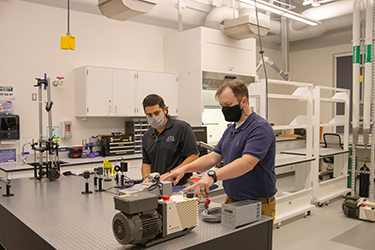
Cole STEM building, room 211.
The Gas Dynamics Lab allows students to investigate complex reactions using laser absorption spectroscopy and record narrow-band chemiluminescence. Data recorded at this facility is of value to transportation, energy, safety and defense industries.
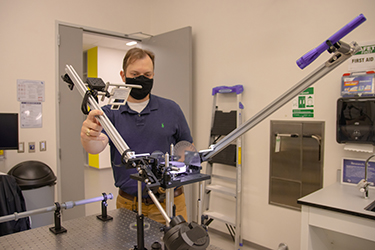
This lab is equipped with a shock tube for the study of chemical kinetics at elevated temperatures and pressures, an absorption cell for spectroscopic parameter characterization and diagnostics for species measurement.
For more information, contact Dr. Christopher Aul.
Quantum Optics and Environmental Sensing Lab
Cole STEM Building, room 209
The Quantum Optics Lab allows students to study the quantum mechanical nature of atomic systems using coherent light. Students can also investigate the status of various ecological zones by examining the interaction of light with the environment through measurements of optical properties such as absorption, scattering, transmission and polarization states.
This lab is equipped with gas lasers, solid state frequency doubled lasers, diode lasers, spectroscopes, oscilloscopes, fiber optic equipment, an optical table, a tunable electronical optical bandpass filter, a scientific CCD camera, Fabry-Perot interferometers, an optical chopper and more.
Research that has been done in this lab includes scattering independent absorption measurements and instrumentation in ocean waters; backscattering instrumentation for ocean optics; using external cavity diode laser systems to look at quantum optic behavior in potassium vapor; conducting standoff heart rate detection using speckle pattern of laser, as well as standoff respiratory monitoring; studying absorption of neural indicators through the human skull; and underground leak detection of methane from a waste collection system.
For more information contact Dr. Joseph Musser.
Radar Signaling Lab
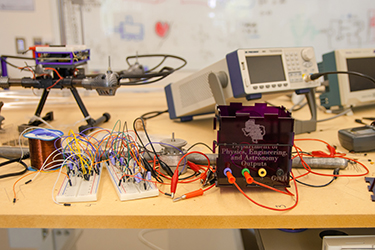
Cole STEM building, room 315.
The Radar Signal Processing Lab allows students to design, fabricate and test printed circuit boards as well as work with software and hardware to develop the next generation of radar systems using the latest technology and algorithms.
This lab is outfitted with state-of-the-art equipment for the design and analysis of electronic circuits.
For more information, contact Dr. Hector Ochoa.
Remote Sensing Lab

Cole STEM building, room 317.
The Remote Sensing Lab allows for research related to polarimetry in remote sensing as well as photogrammetry, including studies involving digital photography, geometric modeling and 3D reconstruction of objects. The lab is equipped with thermal and standard cameras as well as work spaces and equipment for making geometric measurements and polarimetric measurements for light reflected from materials.
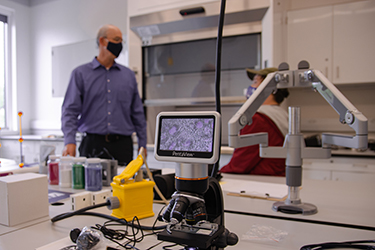
Research that has been conducted in this lab includes modeling polarimetric light reflection from surfaces, developing software for storing, and analyzing polarimetric data and simulations of planetary motion using Runga-Kutta and other time-step measurements. Currently, students are simulating the determination of camera position and orientation using reference objects in scenes and performing numerical solutions for partial differential equations including the heat and Navier Stokes equations.
For more information, contact Dr. James Adams.
Thin Film and Microscopy Lab
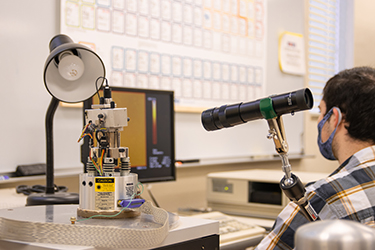
Miller Science Building, room 126
The Thin Film and Microscopy Lab has provided resources for multiple research projects in collaboration with many departments across campus, including the study of pottery fragments from ancient native American cultures with chemistry, archaeology and biology; the study of magnesium compounds found in soil samples with agriculture; and the study of protein molecules found to be complicit in Alzheimer's disease with chemistry and biochemistry.
This lab includes a scanning electron microscope, an energy dispersive spectrometer, an electrochemical analyzer, two tube furnaces, Keithley Instruments Source/Measure Unit, a nano-voltmeter, a picoammeter, an Oriel solar simulator, a Buehler polishing wheel, a spin coater and Nanoscope Scanning Tunneling Microscope/Atomic Force microscope.
For more information, contact Dr. Robert Friedfeld.

 Axe ’Em, Jacks!
Axe ’Em, Jacks!
